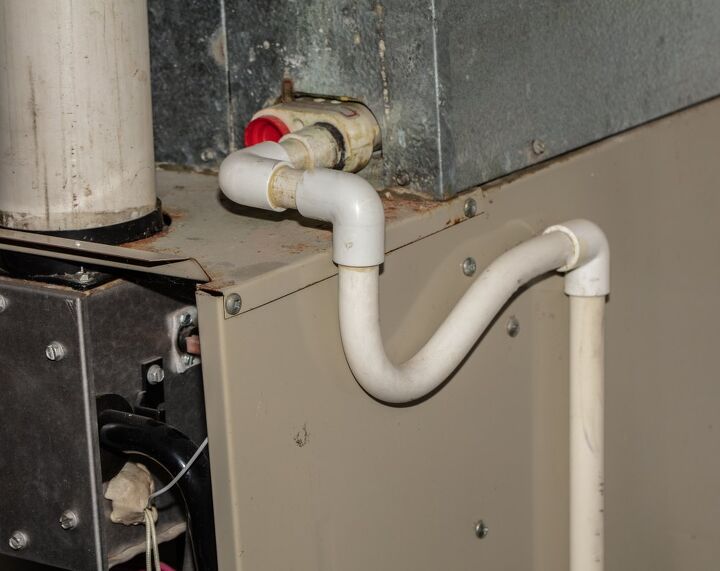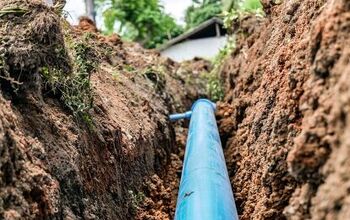How To Keep Furnace Condensate Line From Freezing (Do This!)

Your HVAC system is a complicated piece of equipment. When it is functioning properly, delivering warm or cold air throughout your home, you likely won’t even recognize it. But when issues creep up, it is hard to notice anything but.
When the condensate line, also known as the drain line, becomes frozen, it can play havoc with your HVAC system. Thankfully, there are ways to prevent the condensate line from freezing and becoming an issue. The most effective way is to weatherproof the line as winter weather is often the cause of freezing.
Do You Need a Heating and Cooling Contractor?
Get free, zero-commitment quotes from pro contractors near you.

Why Does the Condensate Line Freeze?
For the most part, the condensate line is not something that the average DIYer is familiar with. The line is one of the most essential aspects of your cooling and heating system. Because it is out of the way, it generally doesn’t cause an issue.
When temperatures plummet in the wintertime, it is not uncommon for water to freeze inside of the condensate line. When the line is frozen, then the system will not be able to properly run. Thankfully, you can take preventative measures to keep it from freezing and becoming an issue.
How to Prevent Your Furnace Condensate Line from Freezing
Thankfully, there are a few ways that you can prevent the condensate line from freezing over. That said, it all comes down to the conditions. If temperatures are below zero on a regular basis, you may have a difficult time preventing freezing.
That said, most areas of the country do not deal with regular subzero temperatures. With these methods, you can give your furnace condensate line a better chance at staying thawed out so that it can perform its job.
Step 1: Insulate the Drain
Perhaps the most effective means of preventing freezing is by insulating the condensate line. There are weatherproof materials that installers can use to line the pipe to prevent it from freezing over in even subzero temperatures.
Call your local HVAC company and inquire about these weatherproof materials. The installation will cost a little but might end up saving a ton in the long run. This may be the most intrusive option and will probably cost the most, too.
Step 2: Use Ice Melt
Another option is to use Ice Melt on the underside of the condensate line’s exit point. You might know it best from its bluish hue when spread out, typically on sidewalks. Ice Melt typically gets laid down before ice and snowfall as a preventative measure, though it can go down over snow and ice that has already formed.
Ice Melt, also known as deicer, works to lower the freezing point of water. That means restricting the buildup of ice or even breaking up ice that has already formed. When it comes to the condensate line, that can be invaluable in keeping your condensate line clear and free of blockage during the coldest months of the year.
Step 3: Apply Heat Tape
Depending on the installation of your HVAC system, your condensate line may be exposed at more than the exit point. When that is the case, you need to provide some type of insulation for the drain line to hold up against subzero temperatures.
Heat tape is a great way to prevent ice buildup in the condensate line. Heat tape can wrap around exposed pipes (your condensate line in this case) to prevent ice dams or ice buildup when temperatures turn frigid.
It is also generally pretty thin and flexible, making it an easy installation. If you can get to your condensate line before temperatures drop, that is the most ideal situation.
What is the Best Option for Preventing Your Condensate Line from Freezing?
There are two important factors when it comes to prevention and those are cost and convenience. Installing weatherproof material is likely the most durable and convenient option but is also the most costly.
You can opt for a money-saving option like heat tape or ice melt, but those may require semi-frequent applications. In the case of the heat tape, it is possible for it to begin peeling back, which would mean re-application.
If you simply want to insulate your condensate line and be done with it, weatherproofing is the right choice. But if you are working on a tight budget and don’t mind having to reapply from time to time, either heat tape or ice melt will work just fine.
Can You Thaw a Frozen Condensate Line?
Perhaps you are reading this and it is too late: your condensate line is already frozen. In this instance, preventative measures won’t do you a whole lot of good. So, the question becomes “can you thaw a frozen condensate line?”
The shower answer is “yes.” You can thaw your condensate line in two different ways. That said, these are very much DIY options. For the most effective thawing of the condensate line, a professional should be the first option.
How to Thaw a Frozen Condensate Line
So, your HVAC system is not working the way that it should and you have come to the realization that the condensate line has frozen over. With a little ingenuity and patience, you can thaw out the condensate line.
There are two primary methods before you will need to involve professional intervention. You can use a hot water bottle or heat wraps that would normally be used for medical purposes to thaw out the condensate line.
Step 1: Hot Water Bottle
This method may take a few applications and quite a bit of time, but it is also the cheapest option there is. All you need to do is fill up a water bottle with hot water and place it on the pipe. The heat should eventually work through the ice, breaking up the blockage.
The problem with this method is that the water bottle will probably cool down rapidly. That means needing to refill it with hot water more than a few times and reapplying to the frozen condensate line. It can be somewhat aggravating to have to refill the bottle and reapply but it will save you a few bucks along the way.
Step 2: Heat Wraps
Another DIY thawing method, one that is a little easier to use than the hot water bottle, is a medical heating pad. People mostly use them for a variety of medical treatments but they can work to thaw out your condensate line in a pinch.
Depending on the type of medical heat wrap that you purchase, you may be facing a similar problem to the water bottle. If you opt for one of the better ones, there is a chance that it could thaw in one application.
If you get an electric heating pad, you can run an extension cord and keep it powered on that way. It would remove the need for reapplication and can get your condensate line thawed out sooner rather than later.
Do You Need a Heating and Cooling Contractor?
Get free, zero-commitment quotes from pro contractors near you.

How Do You Know if You Have a Frozen Condensate Line?
The bad part about this issue is that it is not readily apparent that this is the issue at hand. The furnace or AC will stop working but there are plenty of other reasons why that can happen, so the condensate line may not immediately jump to mind.
Because there could be other issues at play, you will have to troubleshoot your furnace to see where the issue lay.
Troubleshooting the Furnace
The first place to start is with the thermostat. The condensate line does not commonly freeze, so you may be looking at a thermostat issue, be it a bad battery or a simple system setting. If the thermostat isn’t on, check the breaker to ensure that power is going to the area.
The filter could also be at fault. When it is covered in dirt, it is possible that there is a clog somewhere in the system. When air can’t get through the filter, warmth can just back up into the system, eventually overheating other components.
The condensate line should be the last thing that you check. There are several other things that will cause your HVAC system to malfunction first.
Related Articles

Ryan Womeldorf has more than a decade of experience writing. He loves to blog about construction, plumbing, and other home topics. Ryan also loves hockey and a lifelong Buffalo sports fan.
More by Ryan Womeldorf



























